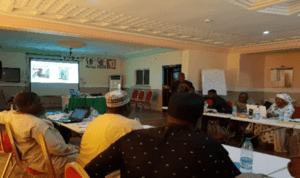Saving Kebbi State from Malnutrition: The Dream of a Local Girl
By Nafisa Abubakar Zaki – Gender, Social Inclusion & Community Engagement Advisor (GSICEA), IHP Kebbi State, Nigeria
The first 1,000 days of a child’s life offer a unique window of opportunity for preventing undernutrition and its consequences. (UNICEF)

With over 11 million stunted children, Nigeria is, without doubt, confronted with the challenge of malnutrition and ranks second with highest number of stunted children globally. For Kebbi, various statistics exist highlighting the severity of the problem.
In a 2018 speech for Maternal Newborn and Child Health Week, wife of the Kebbi State Governor her excellency Zainab Bagudu stated that, “for Kebbi, there are various quoted statistics ranging from 47 to 90 percentage prevalence in 2017, the stunting rate stood at 60.3 per cent well above the national average of 32 per cent…Whatever the figure is, it is too high.”
On Monday 4th November and Tuesday 5th November, 2019 the USAID-funded Integrated Health Program (IHP) in Kebbi State facilitated a Kebbi State Committee on Food and Nutrition (SCFN) meeting to discuss challenges and strategies to improving nutrition status in Kebbi and stimulate critical thinking on advancements.
Specifically, the meeting supported efforts to strengthen Committee coordination to deliver multi- sectoral action, refresh Committee responsibilities aimed at addressing nutrition challenges, and discussed indicators for better monitoring and decision-making.
Various implementing partners and donor agencies have supported Nigerian States by providing funds and implementing an array of key activities to improve the nutritional status of populations. Yet, from my point of view, malnutrition is one of the driving forces of under-five (<5) child morbidity and mortality in Nigeria especially in rural communities.
As a community member, family member, development worker, and role model I feel I have a role to play in ending malnutrition so whenever I hear that a child has died of malnutrition in Kebbi State, I feel guilty and sad. Why? Because I am a stakeholder and believe that malnutrition should be history by now.
In my opinion, one idea I think can work is that if all nutrition stakeholders and advocates can promote, restore, and maintain good nutrition stabilization centers, this will contribute to ensuring responsiveness to nutrition activities that are implemented with improved efficiency.
I believe that if stakeholders, practitioners, and community members start paying attention to unpredictable interactions between actors, sectors, disciplines, and determinants of nutrition. It’s high time for stakeholders working on nutrition to start thinking about the effect that food, health, and education systems have on nutrition practices and outcomes. This will facilitate identification of root causes of malnutrition, solutions, and also bring about positive change.
The USAID Integrated Health Program (IHP), led by Palladium, currently provides technical assistance to three States in Nigeria – Kebbi, Bauchi, and Sokoto – to strengthen health systems and improve access to and quality of RMNCH+NM and primary health care services. Expert gender integration and social inclusion partner, WI-HER, LLC, leads efforts that promote equitable services that reach the most marginalized populations while working to advance IHP goals and objectives.